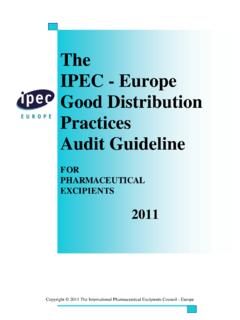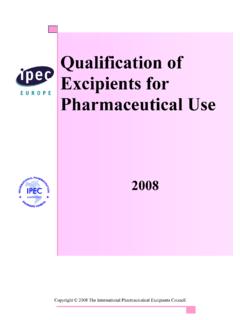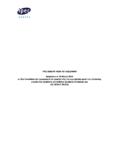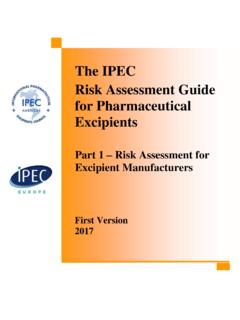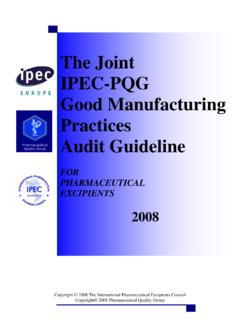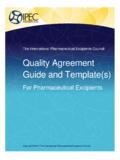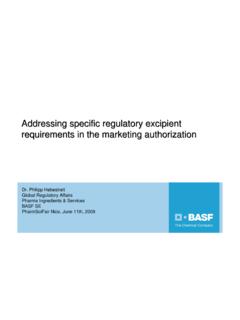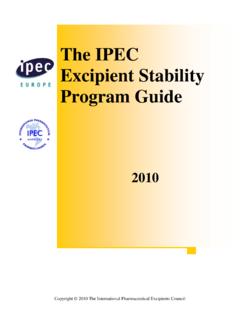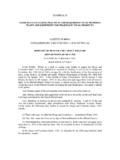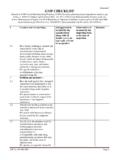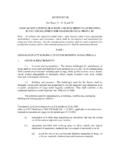Transcription of The Joint IPEC – PQG Good Manufacturing …
1 The Joint ipec PQG. good Manufacturing Practices Guide FOR. PHARMACEUTICAL. EXCIPIENTS. 2006. Copyright 2006 The International Pharmaceutical Excipients Council and Copyright 2006 Pharmaceutical Quality Group FOREWORD. The quality of excipients is critical to assure the safety, quality and efficacy of medicines. Excipients have a wide range of applications and are essential components of the drug product formulation. Characteristics that excipients impart to formulated drug products include cosmetic appearance, stability and delivery of the active ingredient. Therefore, applying appropriate good Manufacturing Practice (GMP) principles to excipients is essential. In contrast to finished dosage forms and Active Pharmaceutical Ingredients (APIs), there are no specific GMP regulations for excipients. In addition, there are a large number of applications of this diverse range of materials which makes the development of excipient GMP guidelines challenging. However, there is a general expectation that excipients are manufactured to recognised GMP principles.
2 This document proposes GMP appropriate for the manufacture of excipients and is a Joint initiative between the International Pharmaceutical Excipients Council ( ipec ), as ipec -Americas and ipec . Europe and the Pharmaceutical Quality Group (PQG), incorporating the ipec good Manufacturing Practices Guide for Bulk Pharmaceutical Excipients, 2001 with the PQG's PS 9100:2002 Pharmaceutical Excipients. During guide development, the opportunity was taken to make further clarifications of the text and to ensure alignment with the corresponding clauses in ISO 9001. The top-level headings in Sections 4. to 8 of this document match those in Sections 4 to 8 of ISO 9001 with the exception of Section . Change Control. Sub headings have been expanded or reduced from the ISO 9001 structure to provide clarity of text. This Guide makes an essential contribution to the wider understanding and attainment of good Manufacturing practice appropriate for the excipient supply industry. Excipient manufacturers and their customers can be assured that excipients manufactured according to this Guide will meet internationally accepted good Manufacturing practice principles.
3 Copyright 2006 The International Pharmaceutical Excipients Council and Copyright 2006 Pharmaceutical Quality Group Page i TABLE OF CONTENTS. FOREWORD ..i ACKNOWLEDGEMENTS .. v 1 INTRODUCTION .. 1. Purpose and 1. Principles Adopted .. 1. The Guide and its Use .. 1. Application .. 2. Quality System Standard .. 2. Document 2. 2 DEFINITIONS .. 3. 3 GENERAL 3. Pharmaceutical 3. Excipient GMP 3. 4 QUALITY MANAGEMENT SYSTEM- EXCIPIENT QUALITY SYSTEMS .. 3. General Requirements .. 3. Documentation Requirements .. 4. General .. 4. Quality 4. Control of Documents .. 4. Control of Records .. 4. Change 5. 5 MANAGEMENT RESPONSIBILITY .. 5. Management Commitment .. 5. Customer Focus .. 5. Quality 6. 6. Quality 6. Quality Management System Planning .. 6. Responsibility, Authority and Communication .. 6. Responsibility and 6. Management Representative .. 7. Internal 7. Management Review .. 7. General .. 7. Review Input .. 7. Review 7. 6 RESOURCE MANAGEMENT .. 7. Provision of Resources.
4 7. Human 8. General .. 8. Competence, Awareness and Training .. 8. Personnel 8. Infrastructure .. 8. Buildings and Facilities .. 9. Equipment .. 9. Equipment 9. Equipment 9. Copyright 2006 The International Pharmaceutical Excipients Council and Copyright 2006 Pharmaceutical Quality Group Page ii Computer 10. Utilities .. 10. Water .. 10. Work Environment .. 10. Air 10. Controlled Environment .. 11. Cleaning and Sanitary 11. Pest Control .. 11. Lighting .. 11. Drainage .. 11. Washing and Toilet 12. 7 PRODUCT REALISATION .. 12. Planning of Product Realisation .. 12. Customer-related 12. Determination of Requirements Related to the Product .. 12. Review of Requirements Related to the 12. Customer 12. Design and Development .. 13. Purchasing .. 13. Purchasing Process .. 13. Purchasing Information .. 13. Verification of Purchased 13. Production and Service Provision .. 14. Control of Production and Service 14. Production Instructions and 14. Equipment 15. Recovery of Solvents, Mother Liquors and Second Crop Crystallisations.
5 15. In-process Blending or Mixing .. 15. In-process Control .. 16. Packaging and Labelling .. 16. Records of Equipment 16. Validation of Processes for Production and Service Provision .. 16. Identification and Traceability .. 17. Traceability .. 17. Inspection and Test 17. Labelling .. 17. Customer 17. Preservation of Product .. 18. Handling, Storage and Preservation .. 18. Packaging 18. Delivery and 18. Control of Measuring and Monitoring 18. 8 MEASUREMENT, ANALYSIS AND IMPROVEMENT .. 19. General .. 19. Monitoring and Measurement .. 19. Customer 19. Internal Audit .. 19. Monitoring and Measurement of 19. Monitoring and Measurement of 20. Laboratory Controls .. 20. Copyright 2006 The International Pharmaceutical Excipients Council and Copyright 2006 Pharmaceutical Quality Group Page iii Finished Excipient Testing and 21. Out-of-Specification Test Results .. 21. Retained Samples .. 21. Certificates of Analysis .. 21. Impurities .. 21. Stability .. 22. Expiry/Retest 22.
6 Control of Nonconforming 22. Reprocessing .. 23. Reworking .. 23. Returned Excipients .. 23. Analysis of Data .. 23. 24. Continual 24. Corrective Action .. 24. Preventive Action .. 24. APPENDIX A AUDITING 25. A1. Introduction .. 25. A2. GMP Principles .. 25. Control of impurities and 25. Excipient properties and functionality .. 25. Consistency of manufacture and change 26. 26. A3. Application of GMP Principles .. 26. A4. General Auditing Considerations .. 26. A5. Audit Check 27. A6. Documentation and Record Review .. 28. APPENDIX B DEFINITIONS AND GLOSSARY .. 30. APPENDIX C BIBLIOGRAPHY .. 34. Copyright 2006 The International Pharmaceutical Excipients Council and Copyright 2006 Pharmaceutical Quality Group Page iv ACKNOWLEDGEMENTS. This Guide was prepared by a team from The International Pharmaceutical Excipients Council ( ipec ). and the Pharmaceutical Quality Group (PQG). ipec . ipec is an international industry association formed in 1991 by manufacturers and end-users of excipients.
7 It is an association comprising three regional pharmaceutical excipient industry associations covering the United States, Europe and Japan (which are known respectively as ipec -Americas, ipec . Europe and JPEC). ipec 's objective is to contribute to the development and harmonisation of international excipient standards, the introduction of useful new excipients to the marketplace and the development of good Manufacturing practice for excipients. ipec first published its GMP Guide for Bulk Pharmaceutical Excipients in 1995 and it was revised in 2001 to align it with ISO 9001:2000. For further information see PQG. The PQG was formed in 1977 to promote development of a consistent approach to pharmaceutical quality and good Manufacturing practice. The group has since expanded, and in 1990 the PQG published three codes of practice to cover pharmaceutical raw materials, printed and contact packaging materials. In 1995. the codes were revised and were integrated with ISO 9002:1994.
8 The code for raw materials was revised and reissued as PS 9100:2002 Pharmaceutical excipients, an application standard and GMP guide for pharmaceutical excipients. For further information see ipec and PQG greatly appreciate and acknowledge the many hours of hard work the following individuals devoted to creating this Guide and the generous support provided by their employers: CORE REVISION TEAM. ipec -AMERICAS. Sidney A. Goode, Pharm D., RPh., The Dow Chemical Company. Rodney J. H. Gray, PhD., Hercules Incorporated. ipec -EUROPE. Kevin McGlue CSci, CChem, MRSC, Colorcon Patricia Rafidison, RPh., , Dow Corning PQG. Stephen Moss , MBA, CChem, FRSC, MIQA, GlaxoSmithKline Iain Moore, , CChem, MRSC, MIQA, Croda Chemicals Europe Ltd. In addition, ipec -PQG would also like to express its thanks to the management of Colorcon and GSK for the use of their resources and premises. Copyright 2006 The International Pharmaceutical Excipients Council and Copyright 2006 Pharmaceutical Quality Group Page v Joint STEERING COMMITTEE.
9 Prof. Dr. Henk J de Jong Adrian Bone, B Pharm, MRPharmS. Ashley McCraight, BSc, CChem, FRSC, , MIQA. Norman Randall, , FRSC, CChem., FIQA. Ashok V. Katdare, R. Christian Moreton, , , , , (Dip.), CONSULTATION. During the preparation of this document we consulted with ipec and PQG members, excipient and pharmaceutical companies, industry associations and regulatory agencies. Their critical and constructive comments made a significant contribution to the quality of this document. ipec and PQG would like to acknowledge the existing guidance and publications of the FDA, ICH, ISO. and the WHO, which have been considered in the preparation of this Guide (see Bibliography). DOCUMENT EDITING TEAM. The following individuals spent many hours proof reading the document. Alan Mercill Secretary Treasurer- ipec -Americas Allan Whiston Sanofi-aventis, PQG, ipec -Europe John Sullivan Rephine Consultants Ltd, PQG, Brian Matthews Alcon Laboratories, PQG. Robert Haslam Somerset House Consultants, PQG.
10 Sharon Shutler Protherics UK,PQG. Irwin Silverstein ipec -Americas Bill Hewlett Johnson & Johnson, PQG. Tim Dickinson 3M, PQG. Lyndsey Pearce Astra Zeneca, PQG. Martin Dennison Seven Seas, PQG. Kirit Sanghani NHS, PQG. John Swarbrick Borculo Domo Ingredients, ipec -Europe David McLean BSi, PQG. Adam Zaki Tablets2 Buy, PQG. Martine Powell Genzyme, PQG. Copyright 2006 The International Pharmaceutical Excipients Council and Copyright 2006 Pharmaceutical Quality Group Page vi Joint ipec PQG good Manufacturing . PRACTICE GUIDE FOR PHARMACEUTICAL. EXCIPIENTS 2006. This document represents voluntary guidance for the pharmaceutical excipient industry and the contents should not be interpreted as regulatory requirements. Alternatives to the approaches in this Guide may be used to achieve an equivalent level of assurance for excipient quality. 1 INTRODUCTION. Purpose and Scope This document is an internationally accepted Guide that defines the extent and point of application of appropriate good Manufacturing Practice (GMP) principles for excipient manufacture.
